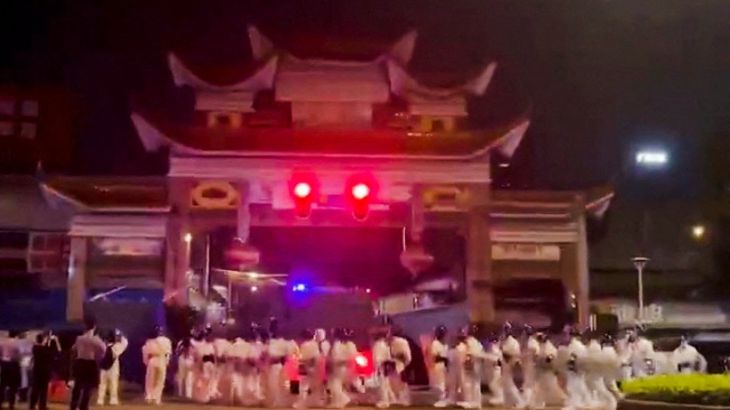China softens COVID stance after protests, clashes with police
Vice Premier Sun Chunlan, who oversees COVID response, says the virus’s ability to cause disease has weakened.

China is softening its tone on the severity of COVID-19 and easing some coronavirus restrictions after anger over the world’s toughest pandemic curbs triggered protests in several cities across the country, some of which led to clashes with police.
With daily cases remaining near record levels even after prolonged lockdowns, Chinese Vice Premier Sun Chunlan, who oversees the country’s coronavirus response, said on Wednesday that the virus’s ability to cause disease was weakening.
Keep reading
list of 3 itemsTwitter rolls back COVID misinformation policy
China ramps up COVID vaccination for elderly after rare protests
“The country is facing a new situation and new tasks in epidemic prevention and control as the pathogenicity of the Omicron virus weakens, more people are vaccinated and experience in containing the virus is accumulated,” state media reported Sun as saying.
Sun also urged further “optimisation” of testing, treatment and quarantine policies.
The mention of a weakening pathogenicity contrasts with earlier messages from authorities about the deadliness of the virus and the need to eradicate it.
Several cities continued to ease district lockdowns and allow businesses to reopen, although they have not directly referenced the protests that gathered momentum after a fire killed 10 people in the locked down Xinjiang city of Urumqi on Friday.
In the southern city of Guangzhou, officials in at least seven districts announced in statements they would lift temporary lockdowns, a day after demonstrators in the southern city clashed with police over the continued curbs on residents’ everyday lives. One district said it would allow in-person classes in schools to resume and would reopen restaurants and other businesses including cinemas.
China’s lockdowns are more severe than any imposed in Western countries – usually confining people to their homes for extended periods and requiring them to submit to regular mass testing.
Al Jazeera’s Patrick Fok, reporting from Hong Kong, said that protests have taken a violent turn in Guangzhou, which has been hard-hit by the recent wave of infections.
“The unrest marks the escalation of a movement that spread to several large cities,” Fok said.
“The latest developments come despite stern warnings against taking part in demonstrations,” he said, adding that China’s top security agency called for a crackdown on what it says are “hostile forces”.
However, it is unclear who or what the government is referring to, Fok said, and it is yet to provide evidence of any external interference.
Some protesters and foreign security experts said the death on Wednesday of former President Jiang Zemin, who led the country for a decade of rapid economic growth after the Tiananmen Square crackdown in 1989, might become a new rallying point for protests three years since the first cases of the virus were identified in the central city of Wuhan.
Jiang’s legacy was being debated on protesters’ Telegram groups, with some saying it gave them a legitimate reason to gather.
‘Sign of weakness’
China Dissent Monitor, run by the US government-funded Freedom House, estimated at least 27 demonstrations took place across China from Saturday to Monday. Australia’s ASPI think-tank estimated 43 protests in 22 cities.
US Secretary of State Antony Blinken said on Wednesday that people in every country should be able to “make known their frustration” through peaceful protests.
“In any country where we see that happening and then we see the government take massive repressive action to stop it, that’s not a sign of strength, that’s a sign of weakness,” Blinken said.
The Global Times, a state-run tabloid, reported this week that several cities were “optimizing” their response “to take more targeted, science-based actions to curb flare-ups”, reflecting advice on the best way to respond to COVID-19 announced earlier this month.
Curbs have also been eased in southwestern Chongqing, where close contacts will be allowed to isolate at home, while in central Zhengzhou, the site of a large Foxconn factory making Apple iPhones that has been the scene of recent unrest over COVID, announced the “orderly” resumption of businesses, including supermarkets, gyms and restaurants.
Earlier, national health officials said China would respond to “urgent concerns” raised by the public and that COVID rules should be implemented more flexibly.
The Global Times, a state-run tabloid, said several cities were now “optimizing” their response “to take more targeted, science-based actions to curb flare-ups”, reflecting advice on COVID-19 responses announced earlier this month.
The Reuters news agency, citing unnamed sources, said the flexible measures include allowing pregnant women, the elderly and people with underlying illnesses to isolate at home. Close contacts of the cases of the cases will also be allowed to isolate at home if the environment meets certain conditions, the sources were quoted as saying.
COVID-19 has spread despite China largely isolating itself from the world and demanding sacrifices from hundreds of millions to comply with relentless testing and isolation.
While the country’s death toll remains low by global standards, analysts said that a re-opening before increasing vaccination rates could lead to widespread illness and deaths.
On Tuesday, the government announced it would step up vaccination for the over-80s, the most at risk group for COVID-19.
Xia Gang, an National Health Commission official in charge of immunisation services, said the space between basic vaccination and booster shots would be reduced to three months for the elderly.